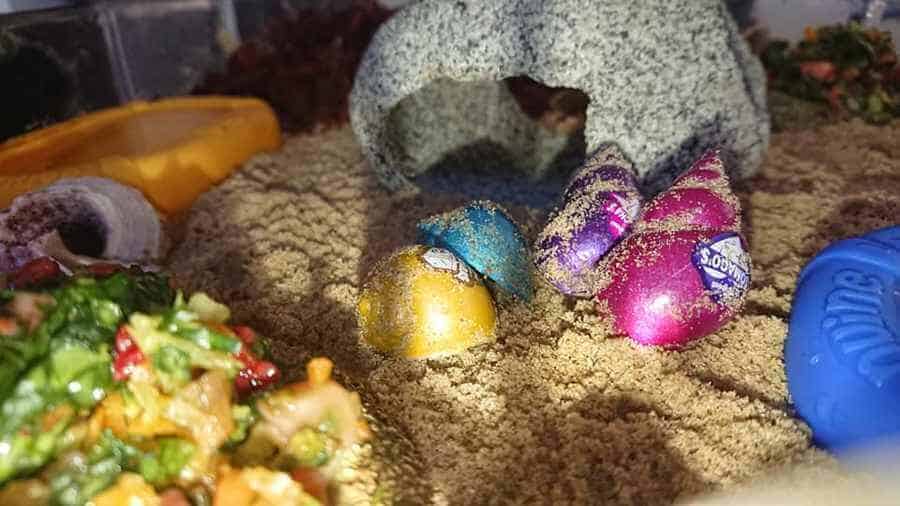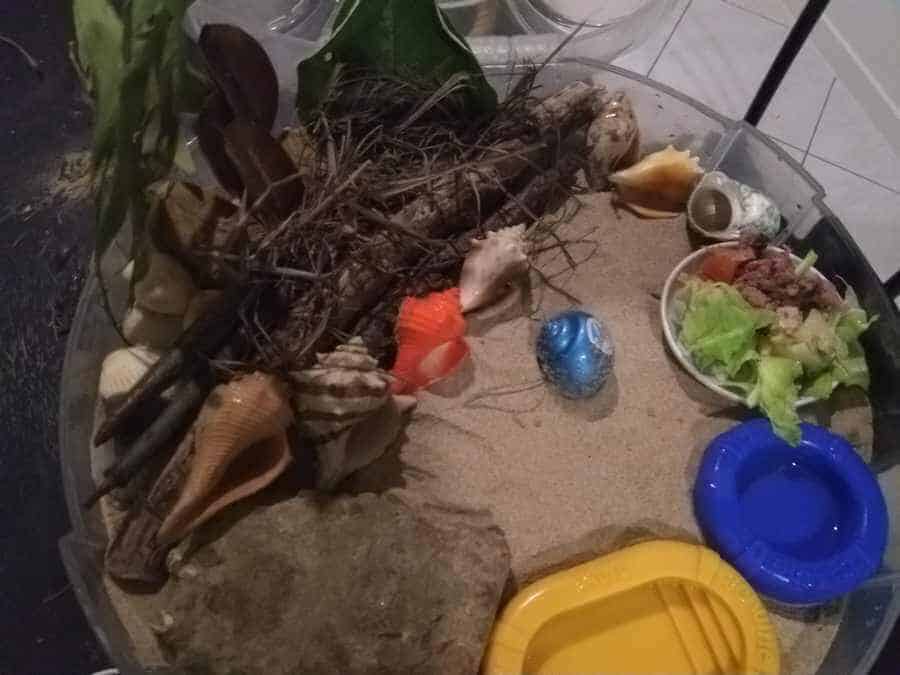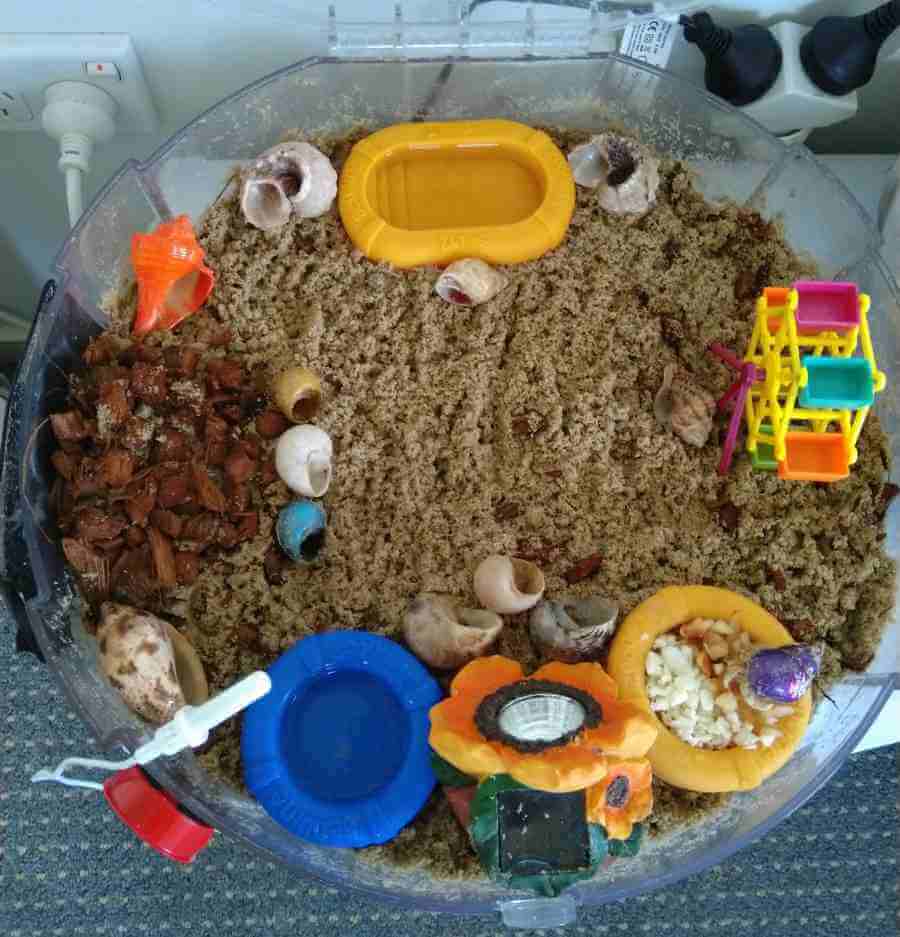Hermit crabs are a truly unique pet that is kept in glass tanks. These tanks serve an exploratory adventure for hermit crabs! Despite their name “hermit” (which implies a reclusive being), they are quite sociable.
They should be kept in pairs or small groups of hermit crabs to help maintain their social nature. The only exception to this is during their molting where they should be kept separate from the group in isolation.
This ensures they can fully shed their exoskeleton without any interruptions. With this said, the tank should be up to 20 gallons (or 76 litres) to give enough space for the group of hermit crabs!
Tank Ideas For Hermit Crabs To Live
The tanks themselves do not have to be boring. In fact, there are some really neat ideas out there to help liven up any hermit crab tank. The most important thing to remember while being creative in a hermit crab tank is that they have everything this need.
This includes water, food, proper humidity levels, and appropriate substrate (sand or other materials for the hermit crab to burrow into).
While that seems like a little bit of hard work, it is simply just a part of being a responsible hermit crab owner.
Overall, there are some fun things to put in their tanks! Below are 10 tank ideas that any hermit crab will appreciate.
1. Use Cholla Wood For Climbing
Cholla Wood, or dried cactus skeleton, is one of the best options for a hermit crab tank. Not only is this material safe for the crab but it helps provide climbing space for exploring! The wood usually comes in a three-pack and can be stacked or arranged in the tank in a variety of ways.
Laying them flat in a row creates a small platform for the crabs to walk. Placing the cholla wood against the side of the tank at an angle provides room for crawling under the wood and onto the wood.
Small hideout spots can be created with 6 or more pieces of cholla wood that can be shaped into something for the crab to crawl inside of as well as climb on top. Cholla wood is truly diverse and is a functioning piece of tank decor.
2. Build a Climbing Structure With Legos
Hermit crabs love climbing so having something in their tank that provides a way for them to climb is important. Legos are a great idea as these building blocks can stack together nicely.
The structure does not have to be elaborate or clunky as to take up too much tank space. A simple set of climbing stairs is sufficient or even a small hideaway in a corner of the tank.
This really adds some creativity to the tank including pops of colour from the Lego blocks themselves. It is important to note that Legos are difficult to clean over other tank items.
This means extra care is needed to ensure that the Legos stay clean. Warm water and q-tips will do the trick just fine.
3. Plant Artificial Plants (Stops Pests)
Plants are always a great way to decorate any space. However, when adding some to a hermit crab tank, they should always be artificial. This ensures that no outside bugs or critters invade the hermit crab’s environment.
These plants can be stuck in any substrate providing green colour to the tank as well as more for the hermit crab to explore. Artificial plants come in all sizes and shapes.
From stocky looking plants to small vines, the options are limitless. Hermit crabs enjoy new things in their tanks, so switching out the plant choice from time to time will make them happy.

4. Incorporate Wood From The Reptile Section of the Pet Store
There are some items in the reptile section of the pet store that are perfectly acceptable things to use in a hermit crab tank. These can include driftwood and coral pieces.
Much like the cholla wood, these items can be stacked or lined up to create climbing space or hideaway space for hermit crabs. Using a combination of cholla wood, driftwood and coral pieces can really add some dimension and variety to a tank environment.
Not only will it look stunning but the hermit crab (or crabs!) will enjoy the different textures of climbing material to investigate.
5. Create a Small Wading Pool
Hermit crabs need access to water and this includes both freshwater and saltwater. To properly achieve this, the water should be in shallow dishes where the crab can climb into the water to swim or wade around.
Some species like the Strawberry Hermit Crab require enough salt water to submerge themselves. This obviously isn’t too deep considering their size, however, a divider in the tank to section off a small area for this is possible.
There should always be a way into the water and a way out. The use of smooth stone or wood can create a walking plank for access. This is true for the small pools for Strawberry Hermit Crabs as well as those who are just using the water dish.
Natural sea sponges are a great choice to put in the pools so that the hermit crab can drink if they want to.
6. Provide an Interesting Backdrop to the Tank
Decorations for a hermit crab’s tank do not have to be limited to the interior. The back of the tank can have a picturesque view that can be secured to the outside and back panel of the tank.
This image can be the beach, outer space, or even a jungle. When looking at the tank from the front, the picture applied can be seen and really amp up the overall look of the tank.
While the hermit crab might not notice this detail, it still is a creative way to make a hermit crab tank more interesting!
7. Use a Night Light or String Lights
It was once thought that the use of lights wasn’t acceptable for hermit crabs. However, very low-wattage lights like night lights or string lights are able to be used.
Hermit crabs do enjoy the soft lighting and these lights add some flare to the tank. The lights should always be placed outside of the tank to shine inside.
Christmas string lights are an excellent choice and can be multi-coloured or clear lighting. Night lights can be clipped to the corner top of a tank to shine down on a specific area of the tank.
8. Build a Tunnel For Hiding Spots
Tunnels are enjoyed by species of animals and this includes the hermit crab! Tunnels are hiding spots as well as a way to play by scurrying through end to end.
When building a tunnel, there should always be a way in and out and the material should be suitable for the hermit crab.
Tunnels can be built out of climbing materials like cholla wood, driftwood, coral, or Legos. There will be endless fun for a hermit crab with these tunnels!

9. Place A Net Bridge For Climbing
Using pre-made net bridges made specifically for hermit crabs is an exclusive way to add fun to a tank. Hermit crabs will easily climb a net bridge (that is properly set in a humid of their cage).
There should always be access on and off the net bridge which can be by smooth stones, cholla wood, etc.
The net bridge also adds a bit more decorated look to any hermit crab tank!
10. Use Rope So They Can Hang Around
A rope is a textured material that is ample enough for a hermit crab to climb. Ropes can be incorporated onto bridges, wading pools, Lego hideaway structures, etc.
They can also just be laid flat on the substrate floor. When the hermit crab goes on an adventure, they will find the textured rope to be a lot of fun!
These 10 hermit crab tank ideas are a crucial way to keep a hermit crab and their buddies happy. With lots of space and different things to explore, they will have endless entertainment.
How Do You Set Up a Hermit Crab Tank?
A hermit crab tank should be set up properly so that the hermit crabs have plenty of space, places to burrow, things to climb, places to hide, somewhere to eat and drink as well as proper humidity control.
All these factors contribute to an ideal tank environment. Knowing how to set up the tank is an important part of getting the tank ready to move in the hermit crabs!
Below are the key steps and things to remember related to setting up a hermit crab tank.
Setting Up a Hermit Crab Tank

Choose The Right Tank
Choosing the right tank is the very first step in having a good environment for hermit crabs. Most tanks are obviously made of glass but some can be plastic.
Plastic tanks generally are smaller and should only be used to isolate a hermit crab for molting. Otherwise, using a glass tank is optimal and the ideal size should be somewhere around 20 gallons (or 76 litres).
While that is a standard size, a step up to a 30 gallon (or 113 litres) tank is also acceptable. Space is everything and size really does matter.
Place A Substrate
Substrate is what lays in the bottom of the tank. Its primary purpose is to provide hermit crabs with space to burrow therefore, the material should be sand or coconut fiber (also known as Forest Bedding).
These two substances are ideal for burrowing and protection. If there is a single hermit crab in the tank, it also helps during molting.
There should be enough sand or coconut fibre in the bottom of the tank to completely cover the hermit crab. This is typically around 4in (or 10cm). This level can be adjusted to meet the needs of the hermit crab, especially if there’s more than one in the tank.
Place Climbing Materials
After picking the right tank size, placing a substrate on the bottom of the tank, the next step is picking out and placing climbing materials. Remember, these items should be coral, driftwood, cholla wood, ropes, or netting.
These materials are essential in giving hermit crabs variety to roam, climb, and explore their environment. Changing up how these items are set up helps to keep them interested as well.
Place Other Tank Items
From artificial plants, water bowls, food bowls, and smooth stones, this is the part where creativity can really kick in. Arranging them in corners of the tank as well as along the backside of the tank are the best ways to incorporate the decor.
This leaves open space towards the front for roaming.
Ensure The Tank Has A Lid
Hermit crabs are small creatures and can find their way outside of the tank. Having a latching lid is the best approach to this issue. It simply makes the lid secure and sturdy to keep hermit crabs within the tank.
Provide Enough Humidity To The Tank
Humidity is important to a hermit crab’s health. Humidity can be created by humidifiers near the tank, misting the tank with treated water (meaning, non-chlorinated), and damp natural sponges.
Keeping the air moist in the tank with humidity encourages a more active hermit crab. A humidity level between 60 to 80% is considered ideal. There are hygrometers on the market that can be installed by the tank to measure the humidity level.
This is a huge help in maintaining the humidity of the tank.
Place A Heating Block
The tank temperature should be maintained at around 75 degrees Fahrenheit (or 24 degrees Celcius). Because hermit crabs are cold-blooded, they do require a little bit of heat to help regulate their body temperatures.
There are specially designed heating blocks that can be attached to the bottom of the glass tank. This is the best location for the heat block as it keeps the substrate warmer.
In combination with the humidity and heating block, the tank should reach optimal warmth levels for hermit crabs. It is important to only use heating blocks appropriate for hermit crabs so that the tank does not get too hot.
While they should be kept warm, too much heat can result in overheating and death.
Put The Tank In An Appropriate Place
Considering the location of the tank is just as important as the setup of the tank itself. It should be placed in an area where it can be seen daily. This helps us to remember to check on the hermit crabs.
The area where the tank is set should also be clear from sprays or air fresheners. Hermit crabs are extremely vulnerable to these items and keeping them away from these situations is absolutely critical.
Place Shells In The Tank
Hermit crabs molt or shed their exoskeleton and require access to new shells to house themselves in. Having a selection of shells handy to put in the tank aids in this process.
When molting happens, the hermit crab may lie on its back appearing dead. However, it usually is not dead and is just prepping itself to shed from its shell. Part of helping in this situation is to provide new shells for them to move into.
What Can I Put in My Hermit Crab Tank?
As expressed before, there should be a substrate and things to climb on and explore. Knowing the appropriate things to put in the tank helps create the best environment for the hermit crabs.
Some things are not suitable for hermit crab tanks while other things are perfectly acceptable. Below are things suitable for a hermit crab tank as well as things that are not suitable!
Acceptable Items for a Hermit Crab Tank
- Driftwood
- Coral
- Cholla wood
- Rope
- Legos
- Smooth Rocks
- Artificial plants
- Old rags
- Corks
Unacceptable Items for a Hermit Crab Tank
- Certain types of wood, like pine
- Bark or sticks (these can be put in the tank but run the risk of having bugs that can invade the tank and should be thoroughly checked)
- Gravel or small rocks
- Artificial plants with wiring inside
- Edible hideaways made for guinea pigs or hamsters
- Table salt (this is related to prepping their salt water. Never use table salt and always use salt sold specifically for creating a salt water mix)
- Any decoration that has paint (paint can have chemicals that are unsafe for hermit crabs)
- A substrate with chemical additives (sand is the preferred substrate and ultimately is the most natural)
- Metal
These lists are good guidance tools for putting the right and appropriate items into a hermit crab tank. Always be mindful of what goes into the tank.
Can a Hermit Crab Live In A 5-Gallon Tank?
There are a lot of tank sizes out there and it might be tempting to purchase a smaller tank to save money. While saving money is important so is the comfort and space given to a hermit crab.
5-gallon tanks (or 19 litres) are smaller in size and can be used to house hermit crabs. The general rule of thumb is 1 gallon of space per hermit crab.
While this is a generic way of looking at the space given to the hermit crabs, it should be noted that aiming for 10 to 30 gallons is better.
There is no harm in having more space. More space is always a better approach. While 5-gallon tanks can be acceptable, the ultimate goal is to give as much space to roam as possible!
Hermit crabs are an interesting pet. Having a functional and creative tank is only the beginning of enjoying the company of a hermit crab! Watching them explore and interact with their environment is also a big part of being a hermit crab owner!
More Pages On Hermit Crabs
Before keeping a hermit crab from the beach, it is important to be fully prepared for having a hermit crab at home. This includes having a proper tank, all the supplies it needs, and proper food....
When people think of pets, they generally think of cats or dogs, even guinea pigs or fish. However, pets truly can come in a variety of animals. This particularly includes the hermit crab. Hermit...

